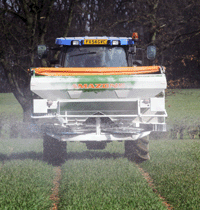Extensive revisions to DEFRA’s fertiliser manual – RB209

Changes to arable crop recommendations in DEFRA’s fertiliser manual have been completed, but the publication date is still unclear.
The current version of RB209 was published in 2000 but concerns that nitrogen, sulphur, phosphorus and organic matter recommendations were outdated prompted DEFRA to initiate an update in 2005.
Finally, two years after it should have been published, the sections for arable and biomass crops are complete, but alterations to grassland information are yet to be finalised, says Rothamsted Research’s Keith Goulding.
To ensure it is simple to use, the layout remains largely the same as the current RB209, he says. “However, every section has been fully revised, making use of all available data and with full and comprehensive consultation.”
Environmental objectives rank highly, particularly in the updated advice on nutrient management and fertiliser use, where there is detailed information on nitrogen supply and losses through run-off and leaching.
A fully revised soil nitrogen supply (SNS) index system is included along with new nitrogen recommendations and a comprehensive section on organic manures. Nitrate Vulnerable Zone regulations are not featured in the report, but they are consistent with it, Prof Goulding believes.
Optimum nitrogen levels have been tweaked for all arable crops and the break-even ratio for wheat has been upped to account for the increased cost of the input.
“Based on trials data, recommendations for wheat have increased by about 30kg/ha reflecting the increased potential yield from new varieties,” says Prof Goulding. “However, the change in break-even ratio from three-to-one to five-to-one makes the table look the same as the old one, apart from fewer blanked-out areas.”
There is a table to help growers determine optimum economic nitrogen rates, he points out, but otherwise the recommendations remain unchanged. Oilseed rape recommendations are also the same as there are no new trials results, he admits.
Average nitrogen recommendations for potatoes have decreased slightly along with phosphate and magnesium, while potash doses have increased slightly, he says. Conversely, suggested nitrogen rates for sugar beet have increased slightly, particularly for an SNS index of greater than two, he says. “It has been made clear that, if growers want to achieve the optimum yield, they will need to ensure that the P and K index is at least two.”
Although the SNS system has been fully revised, the principal remains the same, says Prof Goulding. “Definitions of soil type have been made clearer and users are directed to a flowchart and a table to make identification easier.” Tables have been updated with uncropped land, previously set-aside, moving down an index point.
The risk of sulphur deficiency is becoming more widespread so the manual highlights the importance of sulphur fertilisers, he says. “But recommendations for the diagnosis and prevention of deficiency remain the same.” A map of sulphur deposition, provided by the NERC Centre for Ecology and Hydrology, is also included.
Maintenance of phosphate and potash soil target indices is discussed in detail, emphasising the importance of replacing offtake in harvested crops, he notes. “Build-up applications at indices zero and one have been increased slightly and run-down applications at indices above target have been decreased.” Growers need to maintain P&K indices or yields will start to drop off, he concludes.

